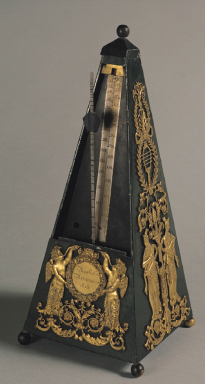3 | Tempo

Our discussion so far has referred to the relative duration of sounds — all beats are equal; some notes are longer than others, and so on — but nothing has been said yet about their absolute duration, in fractions of a second. The term for the speed of music is tempo; in metrical music, the tempo is the rate at which the basic, regular beats of the meter follow one another.
Tempo can be expressed exactly and measured by the metronome, a mechanical or electrical device that ticks out beats at any desired tempo. When composers give directions for tempo, however, they usually prefer approximate terms. Rather than freezing the music’s speed by means of a metronome, they prefer to leave some latitude for different performers. Because all European music looked to Italy when this terminology first came into use, the conventional terms for tempo are Italian:
| COMMON TEMPO INDICATIONS | LESS COMMON TEMPO INDICATIONS | ||
| adagio: | slow | largo, lento, grave: | slow, very slow |
| andante: | on the slow side, but not too slow | larghetto: | somewhat faster than largo |
| moderato: | moderate | andantino: | somewhat faster than andante |
| allegretto: | on the fast side, but not too fast | vivace, vivo: | lively |
| allegro: | fast | molto allegro: | faster than allegro |
| presto: | very fast | prestissimo: | very fast indeed |
It’s interesting that in their original meaning many of these Italian words refer not to speed itself but rather to a mood, action, or quality that can be associated with tempo only in a general way. Thus, vivace is close to our “vivacious,” allegro means “cheerful,” and andante, derived from the Italian word for “go,” might be translated as “walking along steadily.”
The most important terms to remember are those listed under “common tempo indications” above. Composers often use tempo indications alone as headings for major sections, called movements, in long works. Musicians refer to the “Andante” of Beethoven’s Fifth Symphony, meaning a certain movement of the symphony (the second), which Beethoven specified should be played at an andante tempo.